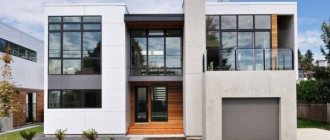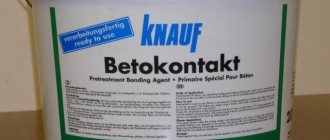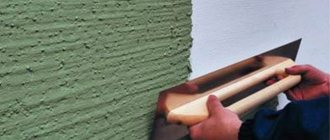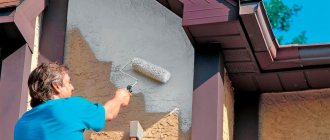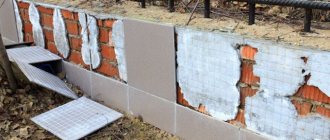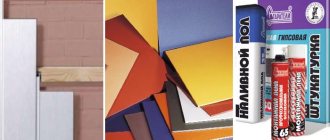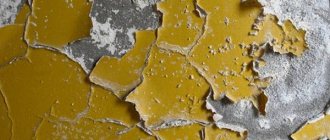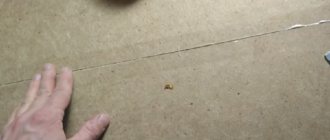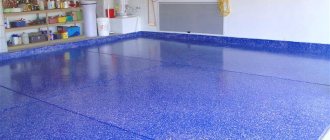Concrete paint protects the porous structure of the building material from external climatic factors. The coating prevents water from penetrating into the surface layers, which become moldy. When applying paint, you must follow the technology recommended by the manufacturer.
Requirements for paints
Basic requirements for paints used for application to concrete surfaces:
- Resistance to mechanical and climatic influences. Mold and mildew should not form on the surface.
- Waterproofness of the resulting layer. The coating must allow water vapor that forms inside the house during operation to pass through.
- Ability to remain on the surface during cyclic changes in temperature and humidity.
- Increased solvent evaporation rate. If it dries for a long time, street dust settles on the painted areas or insects stick to it.
- No odor or toxic components.
The paint applied to the facades should not be destroyed by precipitation or ignite in fires. When purchasing material, the temperature range of application is taken into account. It is recommended to use paints that can withstand temperature changes ranging from -50° to 50°C.
Material selection
Concrete buildings are erected quickly. Walls made of this material can withstand heavy loads. The outer side without finishing is destroyed by wind, moisture, frost, and the inner side has an unsightly appearance .
Both the interior and exterior of concrete buildings need immediate finishing. The easiest way to solve all problems is to paint the walls on the outside with facade paint, and on the inside with interior paint. The question arises: what paint to paint concrete so that its surface does not deteriorate under the influence of atmospheric phenomena and has an attractive appearance? There are a huge number of concrete paints on sale. It is not easy for the consumer to make an exact choice .
Water compositions
Water-based paints are used to decorate concrete walls indoors. They are used (but to a lesser extent) for painting facades. The popularity of this type of coloring compositions is explained by:
- relatively low price;
- easy application;
- instant drying;
- lack of odor;
- possibility of tinting in the desired color with your own hands .
This type of paintwork material is made from synthetic resins, pigments, and fillers, which are diluted with water. The service life of coatings is on average 10 years.
Acrylic
Finishing concrete walls with acrylic compounds is used everywhere, since they have such qualities as:
- excellent adhesion;
- elasticity (does not crack);
- dry quickly;
- protect the coating from the influence of ultraviolet radiation, high and low temperatures, moisture;
- create a “breathing” surface;
- are easy to wash and do not collapse, even if washed with chemicals;
- just tinted.
All characteristics and methods of applying acrylic compositions are indicated on the product packaging. Pay attention to the shine of the product - it can be matte or glossy. In addition, the packaging indicates the composition class, which determines its resistance to washing (the indicator ranges from 1 to 5). Acrylic paints and varnishes can be used to paint only walls, but also concrete floors .
Silicone
This type of water-soluble paint is used for painting concrete surfaces both inside (bathroom, kitchen) and outside buildings, since the composition is resistant to high humidity and can withstand significant temperature changes.
Silicone polymers in the composition of paints and varnishes provide a film on the surface that is characterized by elasticity and vapor permeability. The binding element in the composition is organosilicon resin. After the paint dries, the surface acquires an interesting silky texture.
Silicone paints based on acrylates, which provide good adhesion to the concrete base, are gaining popularity. Concrete walls of facades and interiors coated with combined lacquer materials do not attract dust, are easy to clean, and the film itself retains its attractive appearance and consumer properties for 20–25 years.
Rubber
There is no rubber in this type of paint; the name characterizes the properties of the material, comparable to the elasticity of rubber. The product is made on a water-dispersion basis, to which acrylates and pigments are added. Rubber paint applied to the surface, after drying, forms a polymer film capable of expanding and contracting together with the base under the influence of external factors. The film does not crack or chip, so it is successfully used for painting concrete facades, floors, and walls, even in unheated rooms.
The advantages of the compositions include good adhesion to concrete, lack of a sliding effect, vapor permeability, and waterproofing properties. The paint has disadvantages - it is high price, poor hiding power (to get a good result, apply several layers).
Silicate
Concrete facades are painted with silicate compounds. Reliability, strength, and durability of the coating are ensured by liquid glass, on the basis of which this type of paint and varnish is made. The façade of a building, finished with silicate material, retains its properties for a long time (strength, resistance to chemical weathering, color, etc.). The coating provides reliable fire protection to the walls, and also prevents the appearance of fungus and mold on them. Despite the high wear resistance of decor based on silicate material, it cracks over time, since it does not have the elasticity characteristic of other types of water-based paint.
Organic paints
Organic-based paints emit a strong, unpleasant odor and take a long time to dry. At the same time, the concrete surface painted with them receives reliable protection from the influence of an aggressive environment.
Oily
Oil paints are used primarily for exterior finishing of concrete walls. Due to the pungent odor and long drying time, interior work is not carried out with these compounds. On concrete façade walls, the dried film adheres firmly, is not destroyed by moisture or ultraviolet radiation, and is easy to wash and clean. However, the film is not elastic and cracks as a result of shrinkage of the foundation and walls. The paint may change color over time due to the drying oil it contains, which turns yellow. The surface after finishing with an oil composition does not “breathe” well. Oil paint is a cheap type of decor for concrete walls.
Alkyd
This type of finish is prepared on the basis of alkyd resin with the addition of driers, which set the drying time of the film. Depending on the fat content of the resin, the compositions acquire certain properties - they are diluted with solvents, drying oil, white spirit, turpentine, gasoline.
The composition is perfectly absorbed into the concrete base, forms a durable coating on the surface, which is resistant to abrasion and weathering, but is resistant to alkali and acid, and is a fire hazard. It is not recommended to use the material for interior decoration due to the pungent odor that persists after drying.
The paint is suitable for decorating warehouses, garages, retail outlets – where the load on concrete walls and floors is high. The composition dries quickly and does not change color over time.
Types of paints for exterior use
Paint and varnish materials used for painting concrete floor slabs and walls are divided into categories:
- Water based dyes. The material contains synthetic resins, fillers and pigment. Paints are characterized by increased resistance to ultraviolet radiation, withstand temperature changes and do not collapse under mechanical stress. The protective layer allows vapor to pass through; re-painting of the surface is required after 8-10 years.
- Materials based on organic solvents that can be applied to concrete bases at subzero temperatures. The disadvantage of paints is the toxicity and flammability of the solvent (for example, white spirit or solvent). The painted surface does not fade when exposed to sunlight, and the paint layer is not washed off with water.
- To obtain a glossy finish that is resistant to mechanical stress, silicate paint is used. It is based on liquid potassium glass with increased strength. Additives based on silicon powder, zinc or aluminum are added to the solution. Metal components provide surface protection against corrosion. The service life of the coating is up to 20 years without loss of original color. The disadvantage is the increased cost and the need to mix the components before use.
Limestone
Powder-type lime materials for interior use are intended for dilution with water. To increase mechanical strength, natural drying oil is added to the solution. The material can be used to paint the external surfaces of buildings. First, the working plane is leveled, cleaned of dust and impregnated with acrylic primer. The paint is applied with a roller or spray. To ensure a uniform layer, work is carried out in cloudy weather.
The materials require impregnation of concrete with primers made from lime paste and table salt. For external walls, a lime-based primer is used with the addition of laundry soap and natural drying oil. To treat contaminated surfaces, increase the amount of drying oil in the solution. The paint is applied in several layers with intermediate drying and visual inspection of the work result. The coating is destroyed under the influence of temperature changes and precipitation within 2-3 years.
Water-based
The material consists of water in which binders and pigment are dissolved. The paint is odorless and is recommended for use on floors and walls indoors. After the water evaporates, a wear-resistant film remains. The protective layer has microscopic pores through which vapors of liquids escape from the concrete.
Facade water-based paints have increased resistance to low temperatures due to the introduction of additional additives.
The solution for external work contains additives that prevent the appearance of mold or mildew on concrete foundations and walls. If the paint is applied by spray, then components are added to the solution to reduce foaming.
The coating remains on the surface of concrete houses for 5 years, provided that the technology is followed. Water-based paints should not be applied in rainy weather, since water washes away the dye components and streaks form on the surface.
Oily
Oil-based materials are a mixture of natural drying oil with fillers (for example, barium sulfate powder) and a pigment that determines the color of the dye. After application to a concrete base, the substance dries for 12-24 hours, releasing drying oil vapors. The protective layer does not allow evaporation from concrete to pass through, which negatively affects the durability of the coating. Oil paint is not frost-resistant, so the material is rarely used on concrete walls on the outside of a house.
Water-epoxy
Water-based epoxy paints and varnishes are supplied as a kit, including a base solution and a hardener. Before application, the components are mixed in a separate container in accordance with the manufacturer's recommendations.
The pigment is introduced at the factory or added to the solution before painting the concrete base. Application of the substance at negative temperatures is allowed. The strength of the layer depends on the amount of hardener and the quality of paint preparation.
The technology of applying epoxy dye to wet concrete can increase the strength of the base. The surface does not change color under mechanical stress or irradiation with ultraviolet rays.
The epoxy base contains harmful substances; the dye is used outdoors or indoors with an organized ventilation system until it hardens. The protective moisture-resistant layer is not destroyed by chemical reagents (for example, acid or alkaline based).
Acrylic silicone
The acrylic-silicone-based painting material contains polymer resins and additives that increase adhesion to the concrete base. The dye contains silicon compounds that increase the strength of the paintwork. The material is intended for use inside the house and for painting external walls. The downside is the limited number of colors.
Water is used to dilute the material to the required consistency; painting is done with a roller, brush or spray gun.
The resulting protective layer is resistant to moisture, and it is possible to remove contaminants with water. The material does not emit harmful substances when drying and during operation, air temperature changes do not destroy the coating. The dye is applied to the walls in 2-3 layers with pauses lasting 5-6 hours to evaporate water from the paint coating.
Acrylic
Polymer-based dyes have good adhesion to the base, which has been previously cleaned of grease stains and dust. Acrylic paints can be used indoors and do not release toxic fumes when dry. An elastic water-repellent film ensures ventilation of the concrete base; the color of the dye is adjusted by introducing dry or liquid pigment. Acrylic materials form a heat-resistant protective layer that is not destroyed by mechanical stress.
Water or organic solvents are used to dissolve paints. Water-based environmentally friendly materials can be used indoors. Spilled paint is removed with a damp sponge or washed off; dried material is not washed away by water. Organic acrylic dyes are resistant to low temperatures and can be applied in winter.
Polymer and vinyl
To protect concrete from atmospheric influences, polyurethane-based materials are used. The paint is used inside and outside the building; the disadvantage is the long drying time (up to 14 days). The applied layer gains strength 2-3 days after the work. Polymer and vinyl materials are used in rooms with increased requirements for wear resistance (for example, at car service stations).
Vinyl paints harden in 2-3 hours; as the air temperature rises, the rate of solvent evaporation increases.
Manufacturers recommend applying the material at temperatures up to 20°C. The paint forms a uniform protective layer; repainting the surface is not required, which reduces material consumption. The service life of the coating reaches 7 years.
Latex
Latex paints and varnishes are made from a suspension of synthetic rubber in a styrene-butadiene solvent. To obtain good resistance to low temperatures, polyester or alkyd resins are added to the mixture.
Due to the introduction of additives, the characteristics and adhesion of the paint change; before applying it to concrete, it is necessary to clarify the purpose of the material (indicated on the factory label). Manufacturers offer materials with matte, glossy and partially matte surfaces.
The resulting layer allows water vapor and air to pass through, ensuring the removal of excess moisture from the concrete. To remove dirt from the decorative coating, use sponges moistened with water and detergent. Ultraviolet radiation does not change the original color; when the base is deformed, the paint layer does not peel off or burst. An additional advantage of latex is the effect of repelling dust, which does not settle on the painted facades of residential buildings.
Which paint to choose
How to choose the most suitable paint for a concrete surface with such a large number of materials? First of all, we need to highlight paints for exterior use. An important factor is the expiration date indicated on the packaging. Expired material will not provide the required level of protection. Paintwork materials for concrete surfaces must have the following properties:
- Maintain your parameters under mechanical loads;
- Have high porosity - be vapor permeable;
- Ensure moisture resistance so that the coating is not washed off by rain;
- Be frost-resistant;
- Protect the surface from exposure to chemicals;
- Provide protection from UV radiation (sun rays);
- Be non-flammable, fireproof;
- Have a short drying time;
- Prevent the development of mold, fungi and other microorganisms.
Nothing beats rubber concrete paint and we'll tell you why.
To protect concrete facades located near roads with heavy traffic, it is better to use materials with antistatic additives. Glossy paints look very impressive, but for their proper application the surface must be perfectly flat and smooth, otherwise all defects on the facade will be visible. Matte paints mask imperfections due to the diffuse scattering of sunlight.
Features of rubber paint
Rubber paint for concrete floors consists of a mixture of acrylic-type polymers and silicone additives. The composition does not contain organic solvents that form flammable or harmful vapors to human health. There is no odor when drying, which allows you to use rubber paint indoors. The protective layer has increased elasticity (stretches 3-4 times) and does not peel off from concrete slabs when the air temperature changes in the range from -50° to 60°C.
The applied film allows moisture vapor to pass through, and it takes 1-2 hours for the paintwork to dry (at a temperature of 20°C). At elevated air temperatures, the drying speed increases, creating difficulties when applying the material. The paint is applied with a roller or pneumatic spray (depending on the manufacturer of the material). The surface will be anti-slip, the service life of the protective layer is 8-10 years.
If you plan to apply rubber paint, the surface is treated with a sodium phosphate solution, which removes old coatings. Painting is carried out at humidity below 80% in calm weather. The elements to be painted should not be exposed to direct sunlight due to the acceleration of the solvent evaporation process.
To increase wear resistance, it is recommended to apply the dye in thin layers with intermediate drying for 1-2 hours.
Types of exterior paints for concrete
According to the method of dissolution, coloring compositions are divided into:
- Water-soluble - made on the basis of synthetic resins, dissolved in water. These dyes contain additives, as well as pigments and fillers, diluted exclusively with water, which allows them to be used exclusively at temperatures above zero. Such facade paints are vapor-permeable, resistant to UV exposure, temperature fluctuations and mechanical damage. The service life of the coating with applied paint is more than 10 years.
- Dyes diluted with organic solvents (xylene, white spirit, solvent). They allow you to paint surfaces at any temperature, including high humidity. At the same time, they are flammable and toxic, which makes them less popular.
The main components divide façade paints into several types.
Acrylic
Particularly resistant to abrasion. They have excellent elasticity, do not have a toxic effect on human health and do not harm the environment. Such compositions are used sparingly, cover the surface perfectly, providing protection from water while being vapor permeable.
Acrylic compositions are not cheap, especially if they contain a predominant acrylic binder.
Water-based compositions
They are easy to apply to the surface, have a variety of colors and are economical in consumption. They are quite popular because of their affordable cost. At the same time, it also has some disadvantages: a low level of moisture resistance, ease of abrasion, inability to withstand mechanical damage, temperature fluctuations and the action of chemical reagents, and an almost complete lack of protective properties.
Latex dyes
One of the varieties of acrylic dyes, characterized by a higher content in the latex dispersion. Components of this type can be copolymers, PVA glue or acrylic. They are cheaper in cost, but their disadvantage is a shorter service life: after some time, the paint fades and peels off, and the surface of the facade becomes dirty.
Oil dyes
They act as a cheaper option. They provide good protection from water and sunlight, but have some disadvantages: the surface of the facade will take longer to dry after applying the dye, the base of the surface requires preliminary preparation before painting, and the composition has low vapor permeability.
The main advantage of silicate dyes is their high level of adhesion. They are resistant to ultraviolet radiation and temperature changes, have a variety of colors and do not require much time to dry. Silicate paint is applied in three layers, which provides better coverage, since applying one layer will not be enough to hide all existing unevenness in the base.
Table. Technical parameters of organic-soluble paints for concrete.
| Name | Technical specifications | |||
| Acrylic | Perchlorovinyl | Pliolitic | Organo-silicate | |
| Appearance | Homogeneous surface, matte, without wrinkles; | Smooth, homogeneous surface without foreign inclusions, cracks, bubbles | ||
| Viscosity | 60-150 sec.; | 35 | — | 15 |
| Drying (up to III degree) | 24 hours | 8 | 24 | 72 |
| Mass. share of non-volatile substances, % | — | 40 | 55 | 50-59 |
| Covering capacity, g/sq.m | 170 | 150 | 150 | 180 |
| Grinding degree, µm | 100 | 120 | 100 | 80 |
| Resistance to water, h | 24 | 24 | 24 | 72 |
| Resistance to alkalis, h | 24 | 24 | 24 | 72 |
| Lightfastness, h | 24 | 24 | 12 | 24 |
| Adhesion, point | 2 | 2 | 1 | 2 |
| Elasticity when bending, mm | 40 | 5 | 1 | 3 |
How to paint concrete surfaces
Before painting concrete surfaces, the base is prepared, from which the existing coating is removed and greasy stains are washed off. If there are traces of rust (for example, from fittings), they are removed using an abrasive method or chemical reagents. If the technology is violated during surface preparation, then it is impossible to create a weather-resistant layer.
To clean facades of old paint, a jet of water is used (for example, from a portable sink), caustic alkali is used to remove the remains of finishing materials from concrete, and rust is washed off with a mixture of water and copper sulfate (ratio 85 and 15%, respectively). Fatty stains are neutralized with a solution of soda ash (500 g of dry matter per 10 liters of water) or solvents.
The concrete base is sanded with abrasive tools to remove uneven surfaces, and then a layer of plaster is applied to the walls. After finishing sanding and removing any irregularities or depressions, the surface is impregnated with a primer. It is recommended to use a primer that is compatible with the paint that will be applied to concrete surfaces. Dust is removed from the floor covering, which impairs the adhesion of paint to the base.
Applying primer and removing dust helps reduce material consumption and improves the quality of the paint layer.
Application of material to floor coverings and walls
Painting begins with applying a layer of paint to a small area of the floor. After hardening, the strength of the coating is checked. If the paint does not peel off, then work continues; if the layer is destroyed, the concrete is re-treated with a compatible primer. To apply the material to the floor, a spray gun is used; after crystallization, the surface is filled with 2-3 layers of varnish.
Before painting vertical surfaces, apply masking tape to the ceiling and floor. Vertical planes are wiped with a damp cloth or rag to remove remaining dust. Then, using a roller, a layer of paint is applied to the base, and a paint mesh is used to remove excess material. Application of the coating begins from the top edge of the wall, the roller is moved from top to bottom. To fill the corners with paint, use a brush with strong bristles; no hairs should remain on the painted surface.
To improve the quality of the coating, the paint and varnish material is applied in 2 layers, between which there is a pause for drying. After completing the work, the masking tape is removed, and any defects found are painted over with a brush. Then the protective coating is dried naturally at temperatures up to 20°C and humidity up to 70%.
